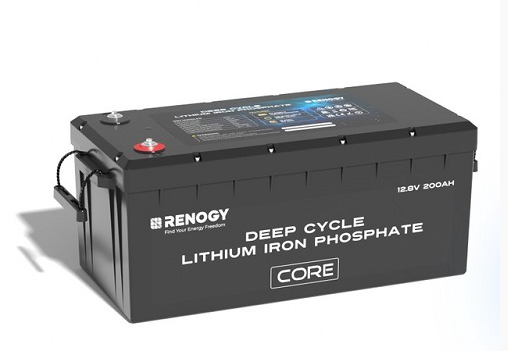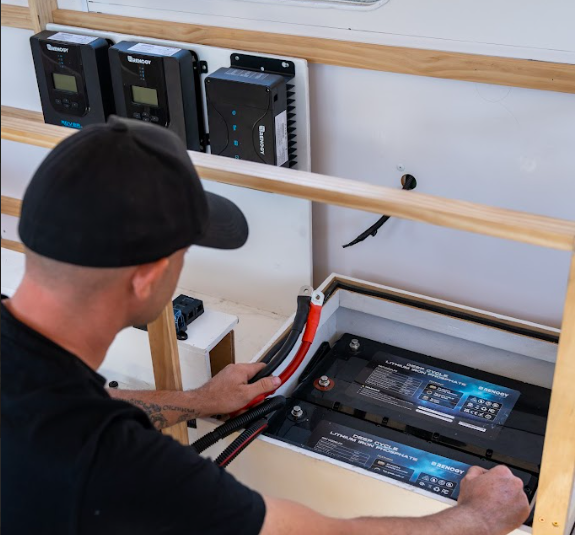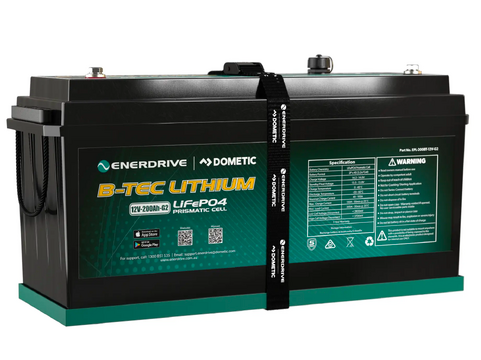Choosing the right caravan battery type is crucial as it determines the performance, lifespan, and efficiency of your power system. In this guide, we’ll explore the key differences between lead-acid and lithium batteries, their advantages and disadvantages, and how to select the best option for your caravan setup.
When travelling through the vast and remote landscapes of Australia, a reliable caravan battery is essential. Power failures in the outback will lead to discomfort or even cut your trip short, leaving you without lighting, refrigeration, or the ability to charge essential devices. Whether you're camping off-grid or staying at powered sites, choosing the right battery is crucial for an uninterrupted and enjoyable experience.
Caravan battery technology has evolved significantly over the years, with a notable shift from traditional lead-acid batteries to more efficient and durable lithium options. While lead-acid batteries, including AGM and gel varieties, remain popular due to their affordability and reliability, lithium batteries are now dominating the market. Their lightweight design, longer lifespan, and superior performance make them an attractive choice for modern caravanners. Understanding the differences between these battery types will help you make an informed decision based on your energy needs and travel style.
Types of Batteries
Let’s start with explaining the two main applications of batteries when travelling in a caravan.
-
Starting Batteries - Also referred to as a cranking battery, is your standard car battery that you’ll find in the engine bay of your 4x4. This is a traditional type of battery that will often be lead acid construction.
-
Deep cycle batteries - Can be referred to as a “house battery” , “Auxillery (Aux) battery” or “caravan battery”. This battery powers all your van’s devices like lighting, refrigeration, water pumps, etc. These can be lead acid or Lithium construction.
.png)
Construction of Lead Acid Starting/Cranking Batteries:
A starting/cranking battery has thinner lead plates inside which help provide a greater surface area of contact between the lead and acid resulting in a reaction that provides more power output and faster recharge times making them ideal for starting or cranking engines. Generally, these types of batteries are used for cars, generators, engines that require short bursts of energy upon start-up. The high output current can be measured by cold cranking amps (CCA). These batteries are designed to be continually recharged, thus holding the maximum capacity charge possible (this is usually between 90%-100% charge). The CCA is more important than Amp hours as it will tell you how much power is in the punch so to speak. High CCA batteries are not used for running appliances while in your caravan. For that application, we focus on deep cycle batteries.
Construction of Lead Acid Deep Cycle Batteries:
A deep cycle battery has thicker lead plates resulting in less surface area contact between the lead and acid which is designed to slowly discharge and recharge making it ideal for running appliances such as fridges and lights while camping.
A deep cycle battery refers to the charge and discharge cycle of the battery. Thus, the more you drain/discharge your battery, the deeper the cycle. This is measured in Amp hours (Ah). Designed to be discharged at a low and consistent amperage over a long period. It is recommended that a deep cycle battery be recharged, above or before reaching 50% battery capacity in order for a longer life. These batteries are available in wet cell, gel and AGM battery varieties.
Construction of AGM “Hybrid” Batteries or “Dual Force” Batteries:
Hybrid AGM (Dual Force) batteries combine design elements from both cranking and deep cycle batteries by using specially formulated lead-calcium plates and an Absorbed Glass Mat (AGM) separator. The plates are thicker than those in a typical starting battery, allowing for repeated deep discharges, but still thin and reactive enough to deliver the high current needed for engine cranking. The AGM construction keeps the electrolyte absorbed in fibreglass mats, making the battery spill-proof, vibration-resistant, and maintenance-free. This hybrid design makes them ideal for dual-purpose applications in caravans and 4WDs where a single battery must handle both starting and deep cycle duties.
Battery Chemistry
When it comes to caravan applications, we can split the two main types of battery chemistry into Lithium and Lead Acid. Within Lithium and Lead Acid, there are variations to explain which will help understand some of the terminology you may have heard, and help in your eventual purchase of a caravan battery?
Lead Acid is the original battery type and still the most common for under-bonnet starting applications, while its deep cycle application in caravans is being outpaced by Lithium, it’s still an option. Traditional Lead Acid batteries are often referred to as “Flooded” batteries as the battery cells are filled with liquid electrolyte (Sufuric acid and water).
During the chemical reaction between the positive and negative Lead Plates and the Electrolyte, energy is produced that you use to power your circuits. The reaction is reversed when an external power source like a battery charger is connected, allowing the battery to be ready for the next use. This process is referred to as one cycle. Knowing how many cycles you can expect from your battery will help you make an informed purchase.
Lead Acid batteries have diversified and developed into AGM (Absorbed Glass Mat) , Gel, Calcium and Lead Crystal Technologies. Let’s take a look at the differences in the main Lead Acid battery types and their construction:
Traditional Flooded Lead-acid Battery
Chemistry:
-
Lead plates suspended in a sulfuric acid and water solution.
-
Chemical reaction between lead and lead dioxide generates electricity.
Pros:
-
Inexpensive upfront cost
-
Can be installed under the bonnet.
Cons:
-
Becoming less common.
-
Shorter lifespan and lower efficiency
Use Cases:
-
Budget- friendly setups or cranking battery applications in a 4x4.
AGM Batteries
Absorbent Glass Mat (AGM) batteries are a type of lead-acid battery where the electrolyte is absorbed in a fiberglass mat, reducing the risk of leakage. These batteries are known for their durability, maintenance-free operation, and budget-friendly pricing, making them a popular choice for caravanners who need reliable power without the higher cost of lithium batteries.
AGM batteries are particularly well-suited for rough terrains, as they are more resistant to shocks and vibrations than traditional flooded lead-acid batteries. This makes them an excellent option for off-road caravanning and situations where battery stability is essential. The AGM battery was a huge step up from traditional flooded lead acid batteries.
Chemistry:
-
Same lead-acid reaction, but immobilized electrolyte.
Pros:
-
Spill-proof and vibration resistant
-
Maintenance-free
-
Charges faster than flooded types
-
Good balance between cost and performance
-
Hybrid or Dual force models available for both cranking and deep cycle applications
Cons:
-
Heavy weight
-
Medium cycle life
-
Can only be discharged down to 50% of their usable capacity.
Use Case:
-
Mid-range caravans, weekenders, dual-purpose setups
Gel Batteries
A gel battery is a VRLA (Valve-Regulated Lead-Acid) battery — just like AGM — but instead of soaking the acid in a fiberglass mat, the electrolyte is turned into a thick gel using silica (sand). This gelled electrolyte doesn’t move around, doesn’t spill, and helps the battery handle deep discharges better than traditional flooded types.
These batteries are highly resistant to high temperatures and deep discharges, making them ideal for hot climates and applications where consistent deep cycling is required. While they offer excellent longevity and safety, they are generally more expensive than AGM batteries and require specific charging profiles to avoid damage.
Chemistry:
-
Lead-acid base, with silica to thicken the electrolyte.
Pros:
-
Excellent deep discharge tolerance
-
Long lifespan in low current draw situations
-
Good for sensitive electronics
-
Very low self-discharge — stores well for long periods
Cons:
-
Slow charging
-
Can't handle high current draw well
-
Need a gel-compatible charger — especially one with proper voltage limits
Use Case:
-
Low draw setups, solar-only vans, electronics-sensitive systems
-
Emergency backup systems
-
Marine and RV setups (especially where vibration or tilt is an issue)
-
Gel batteries have a slower discharge rate than AGM, and are often used on golf carts and mobility scooters.
Lithium Iron Phosphate (LiFePO4) Batteries
Lithium Iron Phosphate (LiFePO4) batteries have revolutionised the caravan battery market due to their superior performance characteristics. These batteries are significantly lighter than lead-acid counterparts, have an extended cycle life (often exceeding 2,000 cycles), and maintain high efficiency in energy transfer. They can also sustain deep discharges without significantly impacting their longevity, making them an excellent choice for off-grid caravan setups.
As home-style creature comforts like coffee machines, induction cooktops and air conditioners become more popular when camping off grid, so does the requirement for a battery that can produce high currents to power them.
Check for the “Maximum Discharge Current” or "Continuous Discharge Current” on the specifications when choosing a battery. A good quality 200Ah LiFePO4 battery might have a discharge current of 200A, which means it has enough current to power a 2000W Inverter for up to an hour. This is something you won’t get out of an AGM battery. Check out our guide to inverters where we dive deeper into battery recommendations for powering inverters while off-grid.
Cycle Life:
A battery’s lifespan is determined by how many cycles it is able to perform. A cycle refers to one full discharge (down to a certain % of capacity) and then a recharge. Batteries are often rated for a certain number of cycles—e.g. 500, 1000, or 2000 cycles.
Depth of Discharge (DoD) is an important specification to look for when choosing a battery, by nature, Lithium Batteries allow for a much deeper discharge than traditional lead acid batteries. Generally, they can be depleted down to an 80% depth of discharge, i.e 20% remaining capacity.
The deeper the discharge cycle the less times you can do it. So when comparing which LiFePO4 battery to choose, factor in the cycle life rating. For example 2000+ Cycles at 80% DoD would be considered an exceptionally high performing battery.
Budget Considerations:
Possibly the biggest change observed in the lithium battery market is the reduction in cost as new products enter the market. A 100Ah lifepo4 battery can now be sourced for under $500, making the barrier to entry much lower. Given this lower cost, consumers are beefing up their battery storage and the 200Ah is fast becoming the entry level size for 4x4 and caravan owners.
While there are many budget options on the market, take the time to review the specifications, warranty support and customer reviews before making a purchase. These basic principles still apply.
It’s possible to find well priced options with a 5 year warranty and over 4 star reviews. Stay away from low warranty options, and if you get the sense that after sales support will be limited from the retailer.
Important specification to check when comparing are:
-
Cycle Life
-
Depth of Discharge
-
Continuous Discharge Current
-
Maximum Charge Current
-
Integrated Battery Management System (BMS)
-
Bluetooth
Integrated Battery Management Systems:
A built in BMS will provide protection for your battery and improve longevity. Most LiFePO4 batteries these days will include a BMS, but there are still a few out there that require an external BMS to be connected. Check the specifications to see what is protected via the BMS. Here is a list of common protections:
-
Over Voltage
-
Under Voltage
-
Temperature
-
Over Current
-
Short Circuit
Bluetooth:
In addition to protection, monitoring your battery's state of health provides peace of mind while travelling off grid. Some advanced Lithium Deep Cycle batteries can be connected and monitored with a smart phone to quickly check parameters like:
-
Battery Capacity
-
Battery Voltage
-
Battery Current (Amps)
-
Battery State of Charge (SOC)
-
Battery State of Health (SOH)
-
Battery Status
-
Individual Cell Voltage
-
Battery Temperature
-
Battery Cycles
-
Battery Alarms
-
Battery Event Information
Lithium vs AGM vs Gel
Choosing between lithium, AGM, and gel batteries involves considering multiple factors, including cost, performance in extreme conditions, and weight efficiency.
Cost Over Time
While lithium batteries have a higher upfront cost, they offer significant savings over time due to their extended lifespan and reduced need for replacements. AGM and gel batteries, though cheaper initially, typically have a lifespan of 3–5 years, whereas lithium batteries can last 10 years or more with proper maintenance. Additionally, lithium batteries maintain their performance levels longer, whereas lead-acid alternatives experience gradual capacity loss over repeated charge cycles.
-
Lithium: Higher initial investment but lower cost per cycle over time.
-
AGM: Affordable upfront but requires more frequent replacements.
-
Gel: Expensive compared to AGM but offers slightly longer life in high-heat applications.
Performance in Extreme Conditions
Different battery chemistries perform better in varying environmental conditions.
-
Heat Tolerance (Gel Batteries): Gel batteries perform exceptionally well in high-temperature environments. Their silica-based electrolyte prevents excessive evaporation and breakdown, making them a preferred choice in hotter climates.
-
Cold Performance (AGM Batteries): AGM batteries outperform both gel and lithium batteries in extreme cold. They maintain better charge retention and discharge efficiency in freezing conditions, making them ideal for alpine or winter camping.
-
Lithium Batteries: While lithium batteries generally handle a wide range of temperatures well, they require integrated heating solutions to operate efficiently in sub-zero temperatures.
Capacity vs Weight
Weight plays a crucial role in caravan and 4WD setups, particularly when optimising payload capacity.
-
Lithium Batteries: Offer the best energy density, meaning more usable amp hours in a smaller and lighter package. A 100Ah lithium battery is about half the weight of an equivalent AGM battery, making it the best option for weight-conscious travellers.
-
AGM Batteries: Heavier and bulkier than lithium alternatives but still a practical choice for those on a budget.
-
Gel Batteries: Similar in weight to AGM but slightly more efficient in terms of usable capacity.
For 4WD setups and off-road caravanning, lithium is often the preferred choice due to its lightweight properties and superior energy efficiency.
Choosing the Right Battery
Selecting the right caravan battery is essential for ensuring reliable power during your travels. The best choice depends on your energy needs, the type of adventures you embark on, and your budget.
Assessing Power Needs
Before investing in a caravan battery, you must determine how much power you require to run your essential appliances and devices. Factors to consider include:
-
Fridges – Portable fridges or built-in caravan fridges can be among the biggest power consumers. A typical 12V compressor fridge may use 30-60Ah per day, while a 3-way fridge running on battery power can drain your system rapidly.
-
Lights – Caravan lights consume minimal energy, usually between 1-5Ah per hour, but older halogen or incandescent lights use significantly more.
-
Inverters – If you plan to use 240V appliances (e.g., microwaves, coffee machines, or laptops), an inverter is required. The larger the inverter, the higher the battery drain.
Calculating Energy Consumption
A very basic guide to selecting your battery size would be to understand and work out your average amp draw from the appliances you plan to run using your battery and multiply this by the length of time in hours you require power. This will give you an approximate total Amp hours required from your battery. To calculate the average amp draw from your appliances, please refer to the product manual for manufacturers specifications.
For example: Say you have an appliance that has an average Amp draw of 5 Amps per hour. You want to run this setup for 20 hours without the use of a charger. (20 hours X 5 Amps per hour = 100AH) You would theoretically need a 100AH rated battery.
Of course there are many factors that will influence the ACTUAL Amp hour output of your battery that often results in less Amp hours than the manufacturers rating. It is best to over-estimate your battery requirements by at least 20- 50% as an absolute minimum.
Best Caravan Battery Brands Compared
|
Brand |
Best For |
Battery Types |
Key Features |
|
Premium lithium choice |
LiFePO4 (Lithium) |
High discharge rates, built-in BMS, Australian-designed |
|
|
Off-grid power users |
LiFePO4 (Lithium), AGM |
Smart Bluetooth monitoring, efficient charging |
|
|
Affordable lithium option |
LiFePO4 (Lithium), AGM |
Budget-friendly, good BMS, solar-ready. Wide range of compatible charging and monitoring equipment. | |
|
Long-lasting lithium performance |
LiFePO4 (Lithium) |
Deep cycle durability, 7+ year lifespan |
Which One Should You Choose?
-
For a premium lithium battery: Enerdrive (solid local Australian after sales support)
-
For a reliable AGM battery: Century Batteries or Power AGM (affordable & durable).
-
For 4WD/caravan dual battery setups: Enerdrive or Renogy (both brands have a full ecosystem of associated charging and monitoring products)
-
For budget lithium: Renogy (good value without premium pricing). Innovative product design with new features being released all the time. Long 5 year warranty available.
What Size Battery Should I Choose?
Caravan and RV power demands have grown significantly over the years due to advancements in technology and the increased need for comfort and connectivity. While appliances have become more energy-efficient thanks to innovations like inverter technology and LED lighting, many travellers now prefer to run all systems — including fridges, lights, and even air conditioners — entirely off battery power, without relying on gas or generators. The first step in choosing the right battery is to identify the appliances you’ll be using and calculate their power draw. You can use this guide to help with those calculations: What Will My Caravan Appliances Draw?.
We've detailed our battery size recommendations below, depending on your setup and how you plan to travel.
|
Battery Size Ah |
Weight Kg |
Use |
Inverter Size |
Minimum Solar Required |
Stay Duration |
|
Lithium |
|||||
|
50-100 |
8-12 |
Led lights Device charging Small fan Portable Fridge Water pump - (short use) Laptop Small Blender Small Microwave (short use) |
500-1000w |
200w |
Weekenders |
|
100-200 |
10-20 |
Led Lights Device charging Fan Tv Laptop Small 12v compressor fridge Microwave on inverter (short use) Induction Cooktop (short use) Starlink Water Pump Diesel and Gas Heater Fans |
1000-2000w inverter |
200-500w |
Weekenders Short Stays |
|
200-300 |
20-30 |
Led Lights Device charging Fans Tv Laptop Large 12v compressor fridge Coffee Machine Induction Cooktop Air Conditioner (small use) Washing Machine (cold wash) Starlink Water Pump Diesel and Gas Heater Fans |
2000-3000w inverter |
500-1000w |
Long Holidays Permanent Travellers |
|
400+ |
40+ |
Led Lights Device Charging Fans Tv Laptop Larger 12v Compressor Fridge Coffee Machine Induction Cooktop Air Conditioner Washing Machine Starlink Water Pump Diesel and Gas Heater Fans |
2600-3000+ inverter |
1000w + |
Long Holidays Permanent Travellers Work and Travellers |
|
AGM |
|||||
|
50-100 |
20-30 |
Small Portable Fridge Led Lights Small Fan Device Charging - limited |
Not recommended |
200w |
Weekender |
|
100-200 |
30-45 |
Led Lights Small Fan Small Portable Fridge TV Device Charging Laptop Small Pod Coffee Machine Small induction cooktop (short use) |
1000w |
400w |
Weekender Short Stays |
|
200-400 |
45-80 |
Led Lights Small Fan Small Portable or Upright Fridge TV Device Charging Laptop Small Pod Coffee Machine Small induction cooktop (short use) |
2000w |
800-1000w |
Short Stays Holidays |
Compatibility Factors
When selecting a battery, you must ensure it is compatible with your caravan’s charging system and voltage requirements.
Most caravan systems run on 12V, but some larger setups use 24V or even 48V systems for heavy power use. Always match your battery voltage to your caravan’s electrical setup.
Charging Systems
-
Solar Panels – If you rely on solar power, ensure your battery is compatible with your solar controller and can efficiently store energy. Lithium batteries are ideal for solar setups due to their high charge efficiency.
-
Alternator Charging – Some caravan batteries can charge while driving through the vehicle’s alternator, but lithium batteries require a DC-DC charger to regulate voltage properly.
-
Mains Charging – If you stay at powered sites, a 240V charger with the correct profile for your battery type (AGM, gel, or lithium) is essential for longevity.
Solar Integration
If your caravan relies on solar power, correctly integrating your panels with your battery system is essential for maximum efficiency.
MPPT vs. PWM Solar Controllers
-
PWM (Pulse Width Modulation) Controllers
-
More affordable but less efficient (suitable for small AGM/Gel battery setups).
-
Works best when solar panel voltage closely matches battery voltage.
-
-
MPPT (Maximum Power Point Tracking) Controllers
-
Converts excess voltage into usable current, boosting solar efficiency by up to 30%.
-
Ideal for lithium batteries and larger solar arrays.
-
Tip: Always check the solar charge controller supports the right charging chemistry. I.e If you have a lithium battery look for a charger that supports a lithium profile.
Sizing Your Solar Panels for Lithium Efficiency
-
Lithium batteries charge faster and more efficiently than AGM/Gel, meaning you need to optimize panel size.
-
Recommended solar input:
-
100Ah Lithium Battery → 200-300W Solar Panels
-
200Ah Lithium Battery → 400-600W Solar Panels
-
-
Solar Regulator Placement – Mount the controller close to the battery to minimize energy loss.
Tip: A tilt-adjustable solar panel mount can improve charging efficiency by up to 40% compared to flat-mounted panels.
For more information on what size solar panels you need for your setup, check out our solar calculator here.
Dual Battery Systems
A dual battery system allows you to run caravan appliances without draining your vehicle’s starter battery. These setups are crucial for off-grid travel and 4WD touring.
Key Components of a Dual Battery System
Battery Isolators
-
Basic solenoid isolators disconnect the auxiliary battery when the engine is off to prevent drainage.
-
Suitable for AGM setups but not ideal for lithium due to inconsistent charge regulation.
DC-DC Chargers
-
Regulates voltage from the alternator to ensure proper charging.
-
Necessary for lithium batteries, as alternators alone cannot fully charge them.
-
Some models have built-in MPPT solar regulators, allowing dual charging from solar + alternator.
Maintenance & Care
Proper battery maintenance ensures longer lifespan, better efficiency, and reliable performance on your travels. Whether you have an AGM, Gel, or Lithium battery, following these care guidelines will prevent common issues and costly replacements.
Routine Checks
Regular inspections and minor upkeep can prevent failures and extend battery life.
Cleaning Terminals & Connections
Over time, battery terminals can corrode, leading to poor conductivity and voltage drops.
How to clean terminals:
-
Disconnect the battery.
-
Use a baking soda + water solution to neutralize corrosion.
-
Scrub terminals with a wire brush and apply petroleum jelly or terminal protector spray to prevent future buildup.
Monitoring Voltage & Charge Levels
Keeping an eye on your battery’s voltage helps you prevent deep discharges and identify early signs of failure.
Voltage Guide for 12V Batteries
-
12.7V - 13.2V → Fully charged
-
12.2V - 12.4V → 50% charged (Recharge ASAP)
-
Below 12.0V → Critically low, may cause permanent damage
-
Over 14.6V while charging → Overcharging risk (Check regulator settings)
Tip: Use a battery monitor with Bluetooth to track voltage in real-time from your phone.
Avoiding Deep Discharges
-
AGM/Gel batteries are best when maintaining charge above 50%, or their lifespan will reduce significantly.
-
Lithium batteries can handle 80-90% discharge, but excessive cycles can still reduce longevity.
-
Consider a low-voltage disconnect (LVD) to automatically shut off loads before damage occurs.
Seasonal Storage
If you’re not using your caravan for extended periods, proper storage is essential to keep your battery in good condition.
Ideal Charge Levels for Storage
-
AGM/Gel batteries → Store at 100% charge, then check every 2-3 months and top up if it drops below 12.6V.
-
Lithium batteries → Store at 40-60% charge for the longest lifespan (Avoid full charge or deep discharge).
Temperature-Controlled Storage Tips
-
Extreme temperatures can damage batteries or cause excessive self-discharge.
-
AGM/Gel: Store in a cool, dry place; avoid below freezing temperatures.
-
Lithium: Store between 5°C - 25°C; avoid below 0°C or above 40°C for extended periods.
-
If storing in the caravan, disconnect the battery from all loads to prevent slow discharge.
Tip: If using solar panels, install a solar charge controller with a float mode to maintain batteries during storage.
Troubleshooting Common Issues
If your battery isn’t performing as expected, these common problems may be the cause:
Voltage Drops & Slow Charging
Possible causes:
-
Loose or corroded terminals → Clean and tighten connections.
-
Thin wiring → Upgrade to thicker cables to reduce voltage drop.
-
Faulty charger → Test with a multimeter to ensure correct output.
Sulfation in AGM & Gel Batteries
Sulfation is a condition where lead sulfate crystals form on plates, reducing capacity.
Symptoms:
-
Battery struggles to hold charge.
-
Voltage stays low even after charging.
Solution:
-
Use a desulfating charger (smart charger with reconditioning mode).
-
Avoid prolonged storage in a discharged state.
Lithium Battery BMS Errors
Lithium batteries have a Battery Management System (BMS) to protect against:
-
Overcharging – BMS shuts down to prevent overheating.
-
Over-discharge – BMS disconnects output when the battery is too low.
-
Overcurrent/Short Circuit – Automatic shutdown to prevent damage.
Fixing a BMS Lockout:
If the battery won’t charge or output power, try resetting the BMS:
-
Disconnect the battery completely for 5-10 minutes.
-
Reconnect and attempt to charge using a low-current charger (e.g., 5A-10A).
-
If still unresponsive, check manufacturer instructions for a hard reset.
Tip: Investing in a battery monitor with a built-in BMS display can help diagnose errors before they become major issues.
Caravan Battery FAQs
-
1. Can I mix lithium and AGM batteries?
No, it's not recommended. Lithium and AGM have different charging voltages and discharge rates, which can cause uneven charging and reduce battery lifespan. If you need both, use separate chargers to manage them independently.
-
2. How do I revive a deeply discharged gel battery?
Try these steps:
- Use a low-amp manual charger (2A-10A) to slowly recharge.
- Connect a fully charged AGM battery in parallel to help jump-start the gel battery.
- Use a smart charger with Recovery Mode (e.g., CTEK MXS 5.0) if available.
If the battery still won’t hold a charge, it may need replacing.
-
3. What’s the best battery for a caravan with a 3000W inverter?
A 3000W inverter needs a large battery bank:
- Best option: 400Ah+ Lithium (12V) or 200Ah+ (24V) for efficiency and long life.
- Budget option: 500Ah+ AGM (12V), but it's heavier and has a shorter lifespan.
- If using 24V, the inverter draws half the current, improving efficiency.
What caravan battery would best suit your caravan setup? Choosing the best caravan battery in Australia depends on your power needs, budget, and travel style. Whether you opt for lithium or AGM caravan batteries, understanding their differences is key—lithium offers superior lifespan and efficiency, while AGM remains a reliable, budget-friendly choice. Investing in high-quality deep cycle batteries for caravans ensures consistent power for fridges, lighting, and appliances, especially when travelling off-grid. For those seeking off-grid caravan power solutions, combining the right battery with solar panels and smart charging systems will provide a seamless, self-sufficient energy setup. With the right knowledge and equipment, you can power your adventures with confidence!
-
DISCLAIMER* Please note, this advice is general in nature and we strongly recommend consulting the product manual and where relevant, a professional installer.
Comments (2)
Mention chargers needed for different types
Eg, will a charger designed to charge an AGM battery still charge a LithiumBy: Terence Richard Roos on 20 December 2022
www.caravanrvcamping.com.au Response
You are best to contact the supplier of your AGM charger to check on its compatibility with lithium. Alternatively you can call us on 1800 787 278 and we can check it out for you









